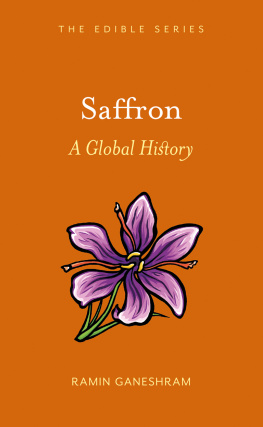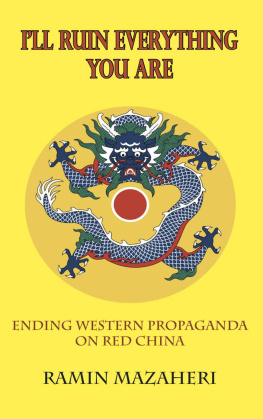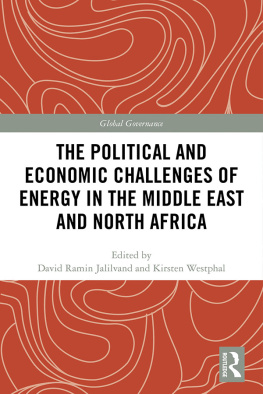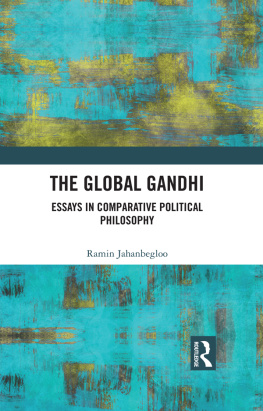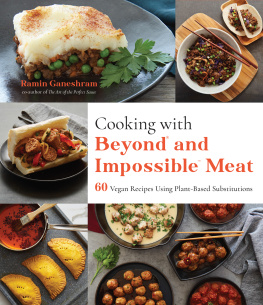Ramin Ganeshram - Saffron A Global History
Here you can read online Ramin Ganeshram - Saffron A Global History full text of the book (entire story) in english for free. Download pdf and epub, get meaning, cover and reviews about this ebook. year: 2020, genre: Religion. Description of the work, (preface) as well as reviews are available. Best literature library LitArk.com created for fans of good reading and offers a wide selection of genres:
Romance novel
Science fiction
Adventure
Detective
Science
History
Home and family
Prose
Art
Politics
Computer
Non-fiction
Religion
Business
Children
Humor
Choose a favorite category and find really read worthwhile books. Enjoy immersion in the world of imagination, feel the emotions of the characters or learn something new for yourself, make an fascinating discovery.
- Book:Saffron A Global History
- Author:
- Genre:
- Year:2020
- Rating:3 / 5
- Favourites:Add to favourites
- Your mark:
- 60
- 1
- 2
- 3
- 4
- 5
Saffron A Global History: summary, description and annotation
We offer to read an annotation, description, summary or preface (depends on what the author of the book "Saffron A Global History" wrote himself). If you haven't found the necessary information about the book — write in the comments, we will try to find it.
Saffron A Global History — read online for free the complete book (whole text) full work
Below is the text of the book, divided by pages. System saving the place of the last page read, allows you to conveniently read the book "Saffron A Global History" online for free, without having to search again every time where you left off. Put a bookmark, and you can go to the page where you finished reading at any time.
Font size:
Interval:
Bookmark:


Edible
Series Editor: Andrew F. Smith
EDIBLE is a revolutionary series of books dedicated to food and drink that explores the rich history of cuisine. Each book reveals the global history and culture of one type of food or beverage.
Already published
Apple Erika Janik, Avocado Jeff Miller, Banana Lorna Piatti-Farnell, Barbecue Jonathan Deutsch and Megan J. Elias, Beans Nathalie Rachel Morris, Beef Lorna Piatti-Farnell, Beer Gavin D. Smith, Berries Heather Arndt Anderson, Biscuits and Cookies Anastasia Edwards, Brandy Becky Sue Epstein, Bread William Rubel, Cabbage Meg Muckenhoupt, Cake Nicola Humble, Caviar Nichola Fletcher, Champagne Becky Sue Epstein, Cheese Andrew Dalby, Chillies Heather Arndt Anderson, Chocolate Sarah Moss and Alexander Badenoch, Cocktails Joseph M. Carlin, Coffee Jonathan Morris, Corn Michael Owen Jones, Curry Colleen Taylor Sen, Dates Nawal Nasrallah, Doughnut Heather Delancey Hunwick, Dumplings Barbara Gallani, Edible Flowers Constance L. Kirker and Mary Newman, Eggs Diane Toops, Fats Michelle Phillipov, Figs David C. Sutton, Game Paula Young Lee, Gin Lesley Jacobs Solmonson, Hamburger Andrew F. Smith, Herbs Gary Allen, Herring Kathy Hunt, Honey Lucy M. Long, Hot Dog Bruce Kraig, Ice Cream Laura B. Weiss, Lamb Brian Yarvin, Lemon Toby Sonneman, Lobster Elisabeth Townsend, Melon Sylvia Lovegren, Milk Hannah Velten, Moonshine Kevin R. Kosar, Mushroom Cynthia D. Bertelsen, Mustard Demet Gzey, Nuts Ken Albala, Offal Nina Edwards, Olive Fabrizia Lanza, Onions and Garlic Martha Jay, Oranges Clarissa Hyman, Oyster Carolyn Tillie, Pancake Ken Albala, Pasta and Noodles Kantha Shelke, Pickles Jan Davison, Pie Janet Clarkson, Pineapple Kaori OConnor, Pizza Carol Helstosky, Pomegranate Damien Stone, Pork Katharine M. Rogers, Potato Andrew F. Smith, Pudding Jeri Quinzio, Rice Renee Marton, Rum Richard Foss, Saffron Ramin Ganeshram, Salad Judith Weinraub, Salmon Nicolaas Mink, Sandwich Bee Wilson, Sauces Maryann Tebben, Sausage Gary Allen, Seaweed Kaori OConnor, Shrimp Yvette Florio Lane, Soup Janet Clarkson, Spices Fred Czarra, Sugar Andrew F. Smith, Sweets and Candy Laura Mason, Tea Helen Saberi, Tequila Ian Williams, Tomato Clarissa Hyman, Trufe Zachary Nowak, Vanilla Rosa Abreu-Runkel, Vodka Patricia Herlihy, Water Ian Miller, Whiskey Kevin R. Kosar, Wine Marc Millon
A Global History
REAKTION BOOKS
In memory of my mother
Published by Reaktion Books Ltd
Unit 32, Waterside
4448 Wharf Road
London N1 7UX, UK
www.reaktionbooks.co.uk
First published 2020
Copyright Ramin Ganeshram 2020
All rights reserved
Page references in the Photo Acknowledgements and
Index match the printed edition of this book.
No part of this publication may be reproduced, stored in a retrieval system, or transmitted, in any form or by any means, electronic, mechanical, photocopying, recording or otherwise, without the prior permission of the publishers
Printed and bound in India by Replika Press Pvt. Ltd
A catalogue record for this book is available from the British Library
eISBN 9781789143294


Thy plants are an orchard of pomegranates with pleasant fruits; camphire, with spikenard. Spikenard and saffron, calamus and cinnamon...
Song of Solomon (4:1314)
Saffron the thin, thread-like stigma of the autumn crocus (Crocus sativus) is the worlds most expensive and, some say, prized ingredient. Delicate in flavour with a unique aroma that some liken to fresh hay and others consider sharper and more astringent to the nose, saffron adds unique taste and colour to dishes. Sadly, modern cooks without a cultural association with saffron often steer clear of the spice, put off both by its cost and by an imperfect understanding of its value as a flavouring and colourant.
Whether saffron is a herb or a spice remains a topic of debate among scholars and culinarians, perhaps because its uses are so broad and span every course of cuisine. It may be that more than any other food product, saffron has consistently maintained an elevated worth over the many millennia that it has been harvested, never losing its value as culinary gold and forever entrenching itself in the human imagination.

Saffron crocus (Crocus sativus L.): flowering stem with separate floral segments and corm and a description of the plant and its uses. Coloured line engraving by C. H. Hemerich, c. 1759, after Timothy Sheldrake.
The high cost of saffron arises largely from the fact that it requires harvesting by hand in precisely the right climate conditions. In developed nations, women and children are most often the harvesters of saffron, not only because their labour is the cheapest, but because the precision needed to pluck an intact crocus stigma from the flower is an act suited to smaller hands.
This labour-intensive crop was first harvested as a wild-flower in ancient Greece and has travelled worldwide both as a finished product and as a cultivar. Today, changing climate conditions are opening up new potential environments for the mass production of saffron beyond the Mediterranean and Middle Eastern locales where it is most often grown.
The preciousness of saffron has made it an attractive ingredient for different activities and industries, such as art, medicine, cosmetics and cloth-dyeing. Saffron traces can be found in cave art in Mesopotamia dating back at least 50,000 years, in the wall frescoes of ancient Santorini, in the dyed wrappings of Egyptian mummies and in the saffron-hued robes of Buddhist monks, but its main use has always been culinary. Saffrons high cost has made it the subject of trade wars throughout history, as well as smuggling schemes.
The importance of saffron was made clear to me as a child. In my parents household, saffron was integral to our native cuisine but often as elusive as a unicorn. I grew up in New York City in the 1970s and 80s, when it was still difficult to obtain all the ingredients one needed to make every dish of my mothers Persian heritage and saffron is an essential ingredient in Iranian cuisine.
I would go with my mother to Sahadis and other Middle Eastern markets on Atlantic Avenue in Brooklyn to get most of the things she needed to prepare her cuisine. But her ever-hopeful enquiries about zereshk (barberries), sohan (a caramelized sugar and nut brittle redolent with saffron) or bastani (saffron-flavoured Persian ice cream) were always met with regretful apologies from the shopkeepers along the Avenue.
Font size:
Interval:
Bookmark:
Similar books «Saffron A Global History»
Look at similar books to Saffron A Global History. We have selected literature similar in name and meaning in the hope of providing readers with more options to find new, interesting, not yet read works.
Discussion, reviews of the book Saffron A Global History and just readers' own opinions. Leave your comments, write what you think about the work, its meaning or the main characters. Specify what exactly you liked and what you didn't like, and why you think so.

